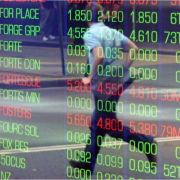Don't fear the doomsayers
| Summary: Some chartists are warning that elevated world asset markets are poised for a deflationary crash. However, they have been making this call for years, and shares have continued to rally regardless. |
| Key take-out: What should you do? Don’t panic. To be on the safe side, apply a stop-loss limit (such as a 50/200 day moving average crossover) to the sharemarket. Exit the market when it falls below its in-year trend, but keep in when it’s above trend. |
| Key beneficiaries: General investors. Category: Strategy. |
The global financial crisis (GFC) can be traced back to America’s housing price crash, which undermined bank mortgages and mortgage-backed securities.
The top portion of the chart below shows that America’s median single-family home price (adjusted for inflation) has jumped dramatically since it bottomed in 2011. Notice that from peak to trough, the price fell 43% in real terms.
The lower portion of the chart shows the semi-annual percentage change in home prices (also adjusted for inflation).
When inflation-adjusted home prices did increase more than 10% in six months, it was often soon followed by a period of stagnant or declining prices. Over the past six months, the median price for a single-family home has shot up at the fastest pace on record.
But the good news is that the worst of the US real estate crisis is over, and with it hopefully the GFC. That’s why bulls such as Adam Carr of Eureka Report (who has called it correctly so far) believe the recent breakout of the All Ordinaries index above its post-GFC resistance line is the start of a climb back to its peak of 2007. (See Adam’s recent article: The ASX is ready for a breakout.
However, Elliott Wave International (which believes in social mood cycles) warns that elevated world asset markets are poised for a deflationary crash because the stockmarket over the last 60 years has risen to unsustainable heights.
Below is a chart of the stockmarket for the last three centuries based on United Kingdom and then US data. EWI thinks the market will return to the path it established between 1790 and 1950, which I have marked with a red arrow.
As further evidence, it presents the following charts comparing commodity, bond and stock price indices in 2013 with their patterns in 1929 (the year that marked the start of the Great Depression).
Robert Prechter, the founder and chief of EWI, correctly predicted the start of the 1982 secular bull market and the crash of October 1987, but he got few other big calls right. He told his clients to short the sharemarket in 1995, yet it rallied for another five years before the 2000 dot.com bust.
He correctly anticipated another boom and bust in his book Conquer the Crash in 2002, but since March 2009 he has predicted the beginning of a grand super-cycle crash with every market pullback, yet shares have continued to rally.
Nonetheless, the US sharemarket looks overvalued by historical standards, according to Professor Robert Shiller’s famous price earnings chart. The Shiller P/E ratio is a better indicator of the market’s value than the normal P/E ratio because it uses earnings over 10 years, not just the last year, and then adjusts earnings to today’s dollars.
Source: http://www.gurufocus.com/shiller-PE.php
On Shiller’s reckoning the market has returned to the unsustainable heights reached by previous secular bull markets. More importantly, past secular bear markets didn’t end until Shiller’s ratio fell to around 5 or 6. At present it’s touching 24. Of course it could return to its long-term trend (of 16.5) by earnings soaring rather than the S&P500 crashing, but corporate earnings as a proportion of GDP are already at a staggering high.
It’s possible, of course, for profits and hence share indices to defy gravity and keep soaring, but the end result would simply be a bigger correction.
Nevertheless, there are few if any analysts that agree with Prechter’s doomsday warning of not just a crash, but the biggest crash since the bursting of the South Sea Bubble in 1720. But suppose for a moment his theory proves right. If so, I am not worried. Because as a market timer my motto is “bull or bear, we don’t care” since I always exit the stockmarket when it falls below its in-year trend, but stay with it while it trades above that trend.
So don’t fear the gloom and doom merchants, keep a positive attitude. But to be on the safe side, apply a stop-loss limit (such as a 50/200 day moving average crossover) to the sharemarket. And to keep it simple, use a listed exchange-traded fund such as the SPDR S&P/ASX 200 Fund (ASX code STW.AX), which moves in sync with the All Ords index and is low cost and highly liquid. That will allow you to enjoy stockmarket booms and abort busts.
Most importantly, it will insure against “black swan” events such as Prechter’s scary scenario of the market plunging back to the path it followed between 1790 and 1950. And it will allow you to focus on the present reality rather than be gripped by fear. That reality is a slowing world economy, but one which governments and central banks will do whatever it takes to stoke growth so as to avoid a repeat of the recent great recession, let alone a great depression like the 1930s.
Percy Allan is a director of MarketTiming.com.au For a free three week trial of its newsletter and trend-trading strategies for listed ETF funds, see www.markettiming.com.au.























